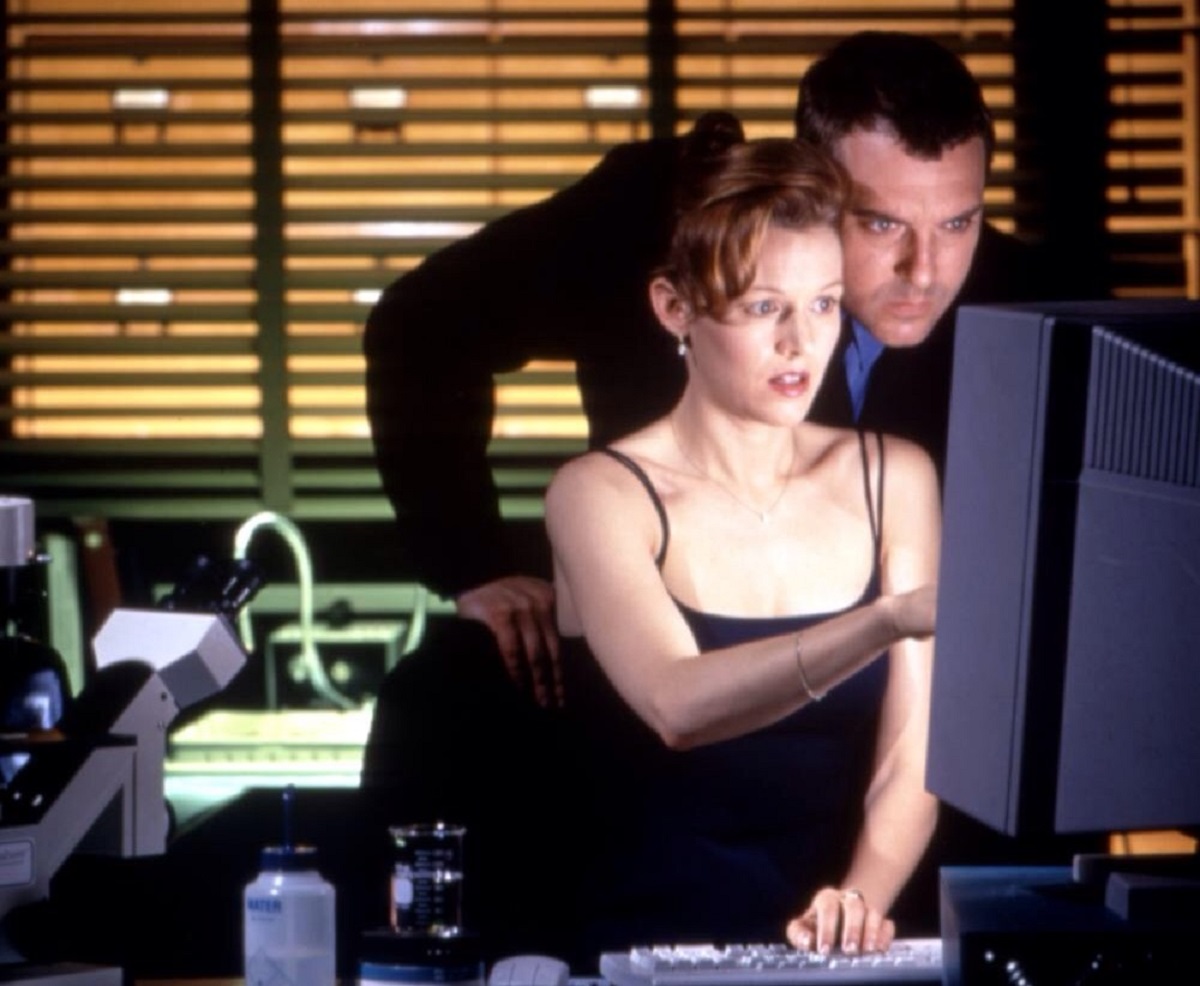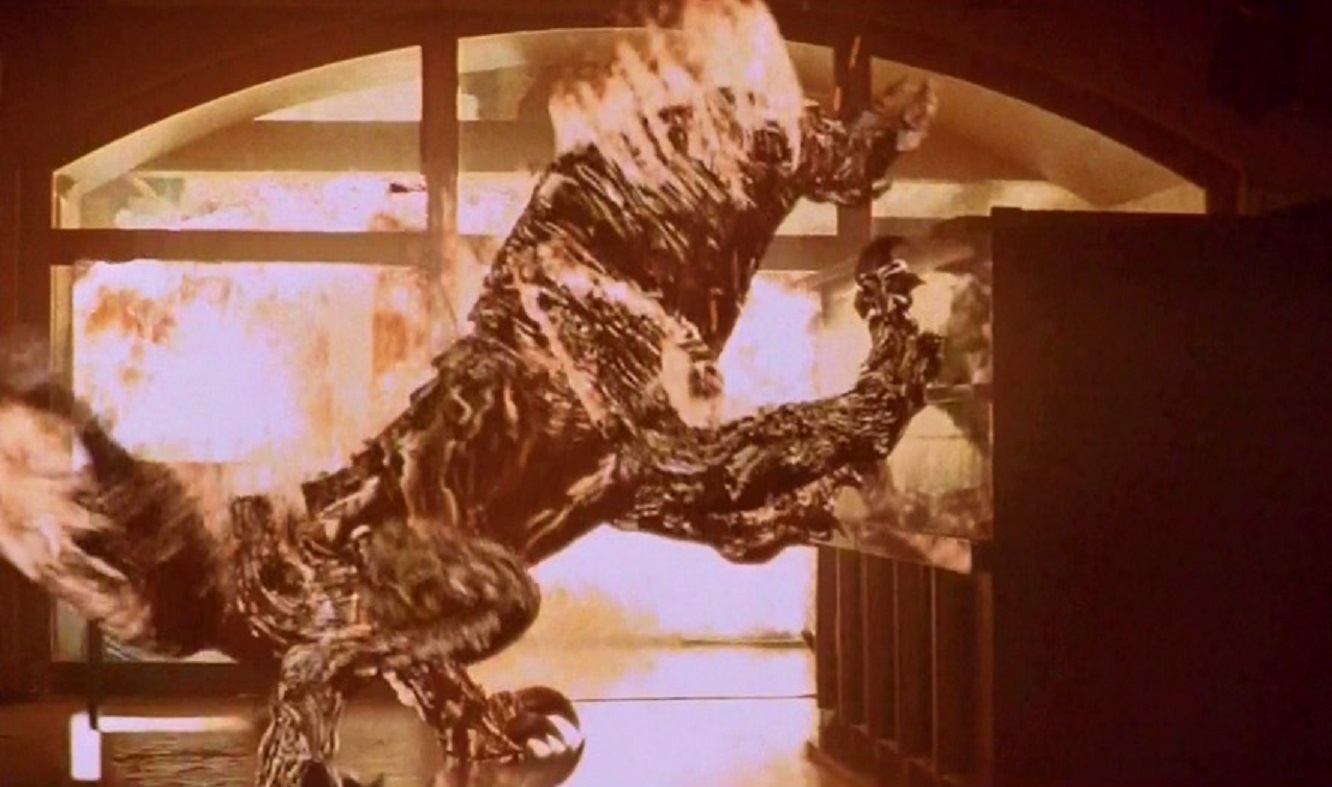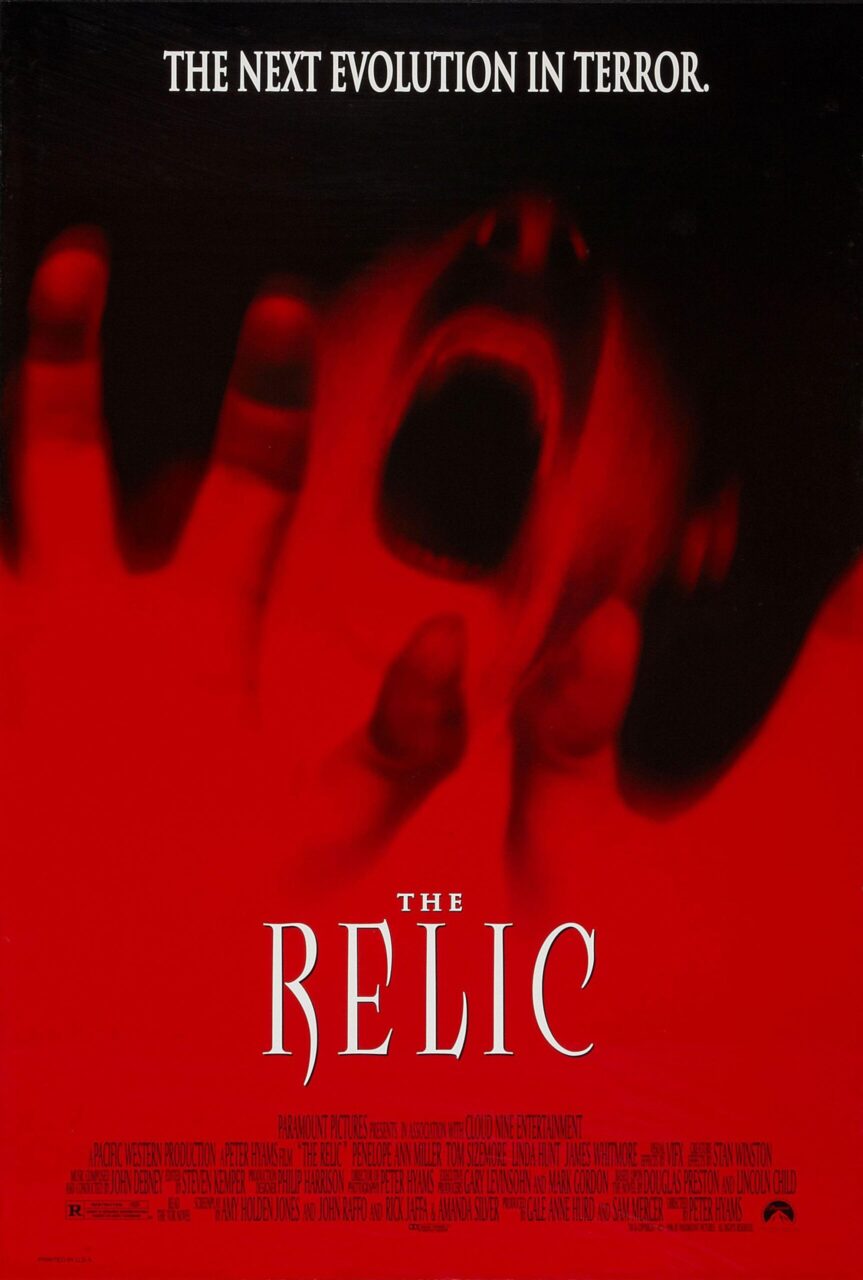Crew
Director/Photography – Peter Hyams, Screenplay – Rick Jaffa, Amy Holden Jones, John Raffo & Amanda Silver, Based on the Novel Relic by Lincoln Child & Douglas Presson, Producers – Gale Anne Hurd & Sam Mercer, Music – John Debney, Visual Effects – VIFX (Supervisor – Gregory L. McMurry), Special Effects Supervisor – Gary Elmendorf, Creature Effects – The Stan Winston Studio (Supervisor – Stan Winston), Production Design – Philip Harrison. Production Company – Cloud Nine Entertainment/Polygram Filmed Entertainment/Marubeni/Toho-Towa/Tele-Munchen/BBC/Paramount/Pacific Western.
Cast
Penelope Ann Miller (Dr Margo Green), Tom Sizemore (Lieutenant Vincent D’Agosta), James Whitmore (Professor Albert Frock), Linda Hunt (Dr Ann Cuthbert), Clayton Rohner (Sergeant Hollingsworth), Chi-Muoi Lo (Greg Lee), Thomas Ryan (Tom Parkinson), Robert Lesser (Mayor Robert Owens)
Plot
A ship arrives in Chicago from Brazil with all of its crew missing. Investigating, police lieutenant Vincent D’Agosta finds slaughtered bodies in the bilge. Two crates from the ship are delivered to Dr Margo Green, an evolutionary biologist at the Natural History Museum. These are found to contain a small stone representation of a South American Indian tribal demon known as Kothoga and a number of leaves, which contain tiny orange seeds that Margo identifies as genetic material. Suddenly there is a series of deaths in the museum, where victims are found with their skulls torn open and the hypothalamuses of the brain devoured. Police find and shoot a wanted rapist, believing that he is responsible for the killings. Margo believes otherwise when she finds genetic material at the scenes that contains DNA mixed from several different animal and insect species. As a high-profile exhibition opens despite her warning, a monster that is capable of absorbing the DNA of its prey emerges to attack the attendees.
Films like Waterworld (1995), Independence Day (1996) and Godzilla (1998) demonstrate that if B-budget films keep imitating their originals long enough the imitations eventually start developing multi-million dollar budgets. The 1990s and beyond brought a host of films such as Species (1995), Mimic (1997), Deep Rising (1998), Virus (1999), Supernova (2000), Dreamcatcher (2003) and of course The Relic, which were largely A-budgeted copies of Alien (1979). Indeed, they were not so much copies of Alien as they were copies of B-budget Alien copies of the 1980s such as Alien Contamination (1980), Xtro (1982), Deep Space (1987) and The Dark Side of the Moon (1990) but conducted with multi-million dollar budgets. So goes the process of Hollywood self-cannibalism.
The film is based on Relic (1995), the debut novel by Lincoln Child and Douglas Presson. The two followed this with a sequel Reliquary (1997), which introduced their character of the FBI agent Aloysius Pendergast, who has gone on to feature in more than twenty other books in which he investigates assorted occult mysteries.
There seems little in the way of originality to The Relic – its principal spin on Alien is to set it in a museum instead of the darkened corridors of a spaceship. The first half of the film is tedious. Here the film seems to consist almost entirely of red herring shocks – cats and derelicts jumping out at people, bodies falling, people playing pranks with medical skeletons or grabbing other’s ankles. The occasional red herring jump in a horror film can be effective – it loosens the audience up for a greater onslaught to come – but director Peter Hyams overdoes this so much that it becomes irritating. One sits back expecting a tiresomely mechanical shock show.

However, during the second half, The Relic defies expectation. During the scenes with the monster stalking victims about in the catacombs of the museum, Peter Hyams turns about and succeeds in cultivating a more than reasonable degree of suspense. (Although, as with the contemporary likes of Se7en (1995) and tv’s Millennium (1996-9), the scenes are filmed so darkly you get the impression that most American cities never stock anything stronger than 20 watt light bulbs).
Aiding the film greatly is one of the few genuinely original post-Alien monsters, courtesy of the Stan Winston workshop. Its appearances are breathtaking – like the moment the giant lumbering monster first appears and then unexpectedly climbs up a wall; its mid-air leap to snatch a cop scaling down a rope from the skylight; or the climax with it running through the museum lit up in brilliant fire.
None of the film requires you to engage your brain – there is much babble about evolution and DNA but it is only scientific doubletalk that has been grafted on to add a pseudo-verisimilitude. There is also an odd motif about superstition that runs through the film – Tom Sizemore’s cop is highly superstitious, the museum has a superstition exhibit – to unclear purpose. Nevertheless, The Relic is one of the more worthwhile Alien imitators.

The Relic was one of a number of genre films made by director Peter Hyams. Hyams first appeared on the genre scene with his fourth film Capricorn One (1978) about a faked Mars landing; Outland (1981), an action film set on one of Jupiter’s moons; and 2010 (1984), the underrated sequel to 2001: A Space Odyssey (1968). All of these are intelligent and original sf films. During this time, Hyams also produced the quirkily appealing Universal monster homage The Monster Squad (1987). Hyams left the genre alone for nearly a decade before returning with a much more routine series of genre offerings, where he has clearly only signed on as a director-for-hire. These include:– Stay Tuned (1992), a comedy where Hell is portrayed as parodies of various tv shows; the reasonable Jean-Claude Van Damme time-travel/action film Timecop (1994); the Arnold Schwarzenegger millennial Devil Returns action film End of Days (1999); and the disastrous Ray Bradbury adaptation A Sound of Thunder (2005) concerning dinosaurs and time-travel.
The Relic was also produced by Gale Anne Hurd, the former wife and producer for James Cameron on films such as The Terminator (1984), Aliens (1986) and The Abyss (1989).
(Nominee for Best Makeup Effects at this site’s Best of 1997 Awards).
Trailer here


